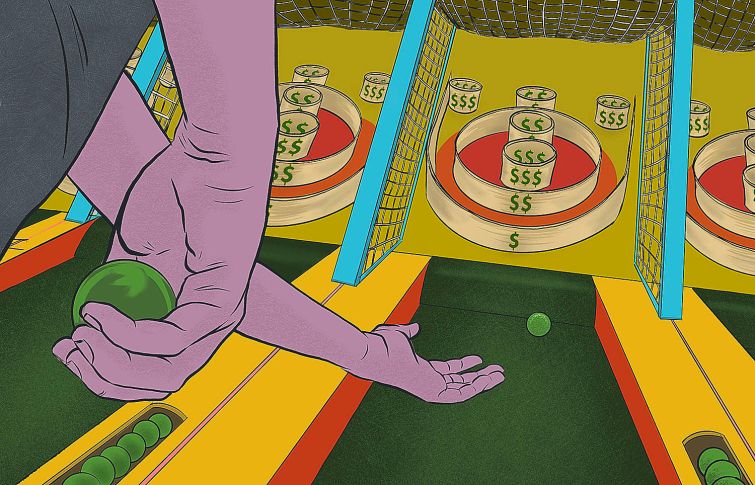Competitive Socializing Proves a Boon for Retailers Post-Pandemic
Real estate loves anything you can throw, putt, toss or hit. Call it fun as an inflation hedge.
By Patrick Sisson June 13, 2023 8:00 am
reprints
Golf, soccer, ax throwing, pickleball, cricket, speakeasies, even baseball. If it involves a group, boasts Instagrammable backgrounds and can be tweaked for more fun, food and beverage spending, then it’s being leveraged as a potential entertainment destination — and a new kind of real estate anchor.
“These venues are really creating more vibrancy for shopping centers that are starting to feel a little dated and are seeking out what that next experience should be,” said Alanna Loeffler, managing director of business strategy at Cushman & Wakefield (CWK).
Birthday parties at Chuck E. Cheese pizza parlors and corporate outings at Dave & Buster’s have been staples for decades, and the experience economy concept gained exposure back in the ’90s when millennials were just kids. But the confluence of a new real estate landscape, interactive technology and entertainment trends — the millennials have grown up, gotten office jobs and moved to the suburbs, and high-density, multifamily urbanization has hit suburban markets across the country — has opened lots of physical and cultural space for new social concepts.
The confluence has also opened investor wallets in search of the next Topgolf, one of the pioneers of the space that arrived in the United States in 2005. A JLL report on entertainment retail found that spending at arcades and amusement parks jumped 20.6 percent annually in the fourth quarter of 2022, with 9.1 million square feet of entertainment space in the pipeline for the U.S. and Canada for the next two years, two-thirds of which is categorized as competitive socializing and “eatertainment” venues.
Retail and commercial landlords have always focused on attracting young adult demographics, seeding repeat customers, and tapping into the latest trends. But the current wave of new entertainment venues has latched onto a larger desire among consumers for local, nontraditional retail and entertainment concepts, said Loeffler. Landlords want more range, and adding a competitive socializing spot makes sense when you’re also adding coworking spaces and health care centers.
As the big retail anchors recede, there’s a long tail of retail developing, with more experimentation, said Ethan Chernofsky, senior vice president of marketing at Placer.ai, a location data firm focused on retail. Others agree.
“Consumers get brand fatigue, and they’re looking for something exciting,” said Naveen Jaggi, president of JLL (JLL)’s Americas retail advisory services. “As our dollars shift from hard goods to experiences, here comes the opportunity to fill that demand. Landlords are saying, ‘We need to offer our consumer more than just another place to buy a T-shirt.’ Therein lies the opportunity for the entertainment sector, and the F&B sector to fill that demand.”
At a time when many of the traditional retail and real estate anchors aren’t performing as well — even one in five Class A-plus malls has a vacant anchor tenant — this new generation of entertainment venues has real value as a traffic magnet for mall and commercial real estate owners and investors, especially if they offer food and beverage programs competitive with other nearby social options. Locations strike a balance between meeting consumers where they are and providing space for concepts that can require up to 45,000 square feet — in many cases, suburban locales near a target demographic of white-collar, work-from-home professionals.
But certain urban locations also work. Swingers indoor mini-golf boasts a large location in Manhattan near Madison Square Park that, in addition to picking up on downtown foot traffic, serves as a massive marketing and branding moment.
Joe Reardon, partner, president and COO of Competitive Social Ventures, which operates a portfolio of sports-, speakeasy- and entertainment-themed brands based in suburban Atlanta, said they scout for locations based on daytime traffic heatmaps, local demographics, and what he calls corporate demand generators. Amid the often uneasy shift to more remote and hybrid work, co-workers and colleagues still make up a significant part of the clientele. Reardon prefers locations on the outskirts of smaller urban centers, guaranteeing more affordable space for larger venues, and the ability to tap both downtown and suburban customer bases.
“We create real value for these developers, an anchor that will continue to draw in the right multifamily or the right restaurants, and the right retail because people want something that’s different, that’s interactive, that also has a food option,” said Reardon. “It’s gonna keep people coming back and staying longer.”
When Puttshack, the English minigolf concept, crossed the pond in 2021, it focused on top-tier markets outside of New York City, Las Vegas and California to show investors and developers the idea can play in cities across the country. Now, it’s looking for 25,000-square-foot spaces, said CEO Joe Vrankin (a former CEO at competitor Topgolf), and can point to locations where it made a mark. These include an adaptive reuse of a Lord & Taylor store at the Oakbrook mall in the Chicago suburbs, where a Puttshack can draw 400,000 visitors annually. It can serve as an anchor, as a Puttshack does in the ground-up Interlock development in Atlanta, which attracts high-end residents, nearby Georgia Tech students and office workers. It’s proven itself to developers like Brookfield Properties, which has opened multiple Puttshacks on its properties.
Imperative to success is site selection, said Vrankin, because Puttshack and other competitive social concepts have been inundated with interest, available space and real estate offers (the concept raised $150 million in growth capital from BlackRock). Puttshack evaluates potential sites based on 52 criteria, including income and demographic statistics, as well as venue visibility and detailed analyses of the local labor market, since each location requires roughly 200 hires.
The current concerns around interest rates and financing have also hit this expanding sector. Cushman’s Loeffler said construction costs are rising, so developers are being more creative with buildout packages and conscious of the costs of materials and fixtures. Vrankin says the financing situation with developers has shifted as retail goes through a rough patch. Whereas in the past, the concept would be on the hook to prove it had the cash to build, he said he’s increasingly making sure the retail landlord has the cash flow and capital to pay for tenant improvement packages in new leases. Those can be $400 a square foot on the high end. JLL found that landlords, despite being bullish on these concepts, may lack the capital or fear taking on too much risk.
“I don’t want to use the R-word, but a recession or challenged environment generally pushes affordable luxuries,” said Chernofsky. “For landlords, it’s an efficiency game, it’s about maximizing the number of swings that they get.”
It’s not just new entertainment concepts gaining momentum as mall anchors and the nexus for new placemaking efforts. At the same time, a raft of midsize sports and concerts venues, accommodating roughly 6,000 to 12,000 fans, are being built in urban infill sites. This is especially true in smaller, multi-use performance venues and stadiums for MLS soccer clubs, such as Toyota Stadium for FC Dallas, where they’re nestled in communities and providing day-and-night gatherings spots.
“Consumers are looking for something that’s conveniently located that’s great entertainment,” said Kevin Taylor, architect and partner at HKS, a leading architectural firm specializing in sports and entertainment venues. “These small to midsize developments that are starting to creep up are centered in and around ballparks, for example.”
While myriad golf, family and pickleball concepts have taken shape, newer brands and concepts, often from overseas, view an increasingly diverse U.S. as fertile ground.
Jaggi said the United States has traditionally been poor at creating these kinds of concepts, and with foreign investors seeking to invest here, importing makes sense. He points to Australia’s Funlab, which owns a portfolio of 30 different concepts, which he heard is “working aggressively” with U.S. property owners.
America’s increasing diversity has also opened up more opportunities with more culturally savvy and experienced consumers with an appetite for something different. Flight Club, a darts concept, and Sixes, a British cricket space opening its first U.S. location in Dallas in late June, might not have found the right stateside reception a few decades ago.
Will today’s hot concept be just a trend, or, worse, tomorrow’s nostalgic punchline? While there’s worry that some concepts may be very limited to certain demographics, or won’t outlast the public’s initial fascination, there’s also certainty that the experience economy concept, and the desire for more entertainment venues, is a secular shift.
CSV’s Reardon said his venues can be converted to other uses and other sports, and expects a consolidation and shakeout within the space. But he doesn’t see good performers going anywhere. Puttshack believes its core offering — patented, software-enabled mini-golf — and its appeal to multiple ages, means it has a unique offering that can constantly be updated. The company plans to hit 15 venues total by the end of the year, with openings scheduled in Addison, Texas; Scottsdale, Ariz.; and Nashville, and then will aim for eight a year — or a new location every 45 days.
“How do you create that Disney where the kids want to go and so do the grandparents?” Vrankin said.
“One of the things the pandemic highlighted to people was that valuable time with friends and family, where you can really do things and create special moments, is much more valuable,” added Vrankin. “But that doesn’t mean everybody’s going to be successful at doing it. And, as a property developer, can you build something that is going to create long-term value?”



